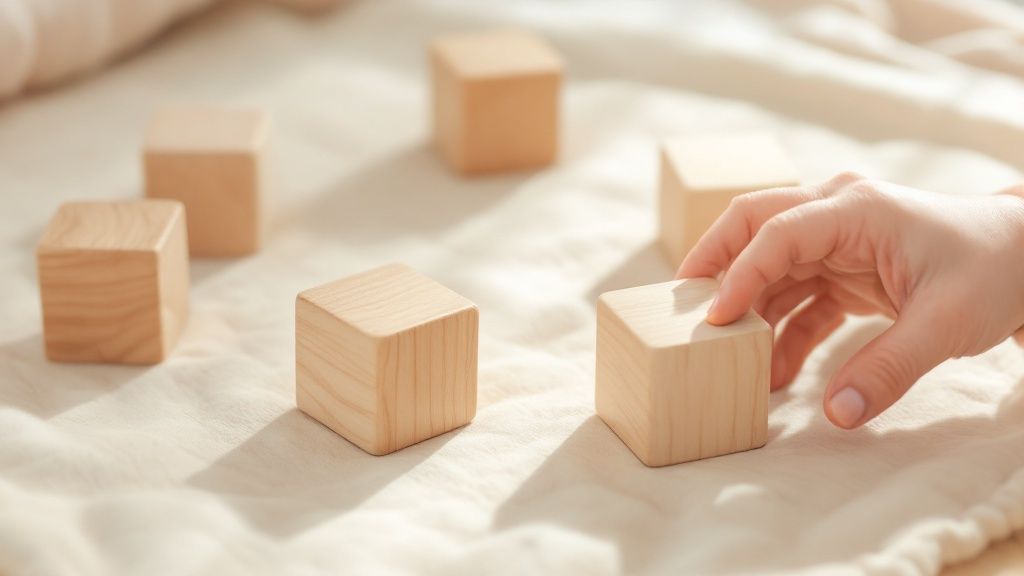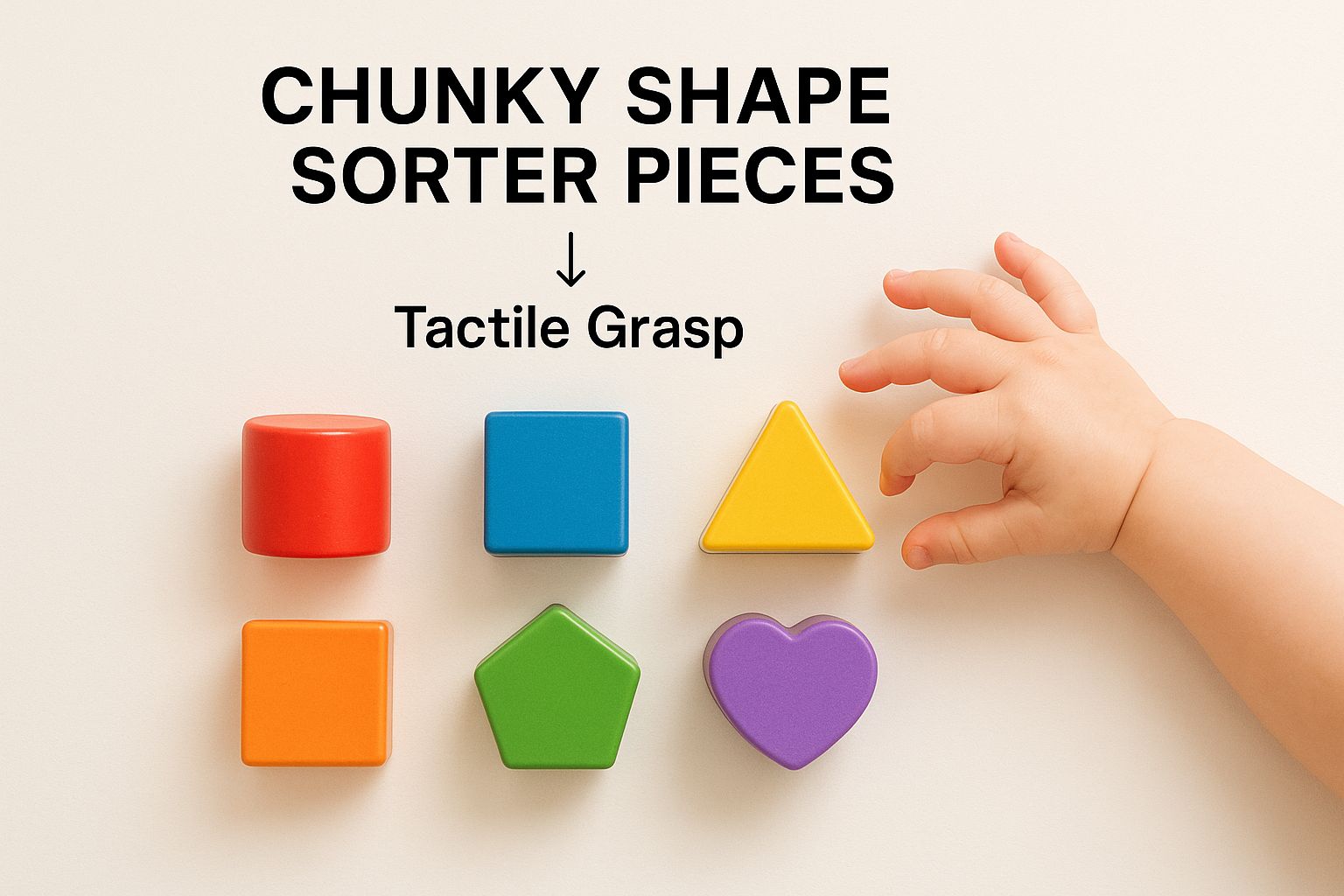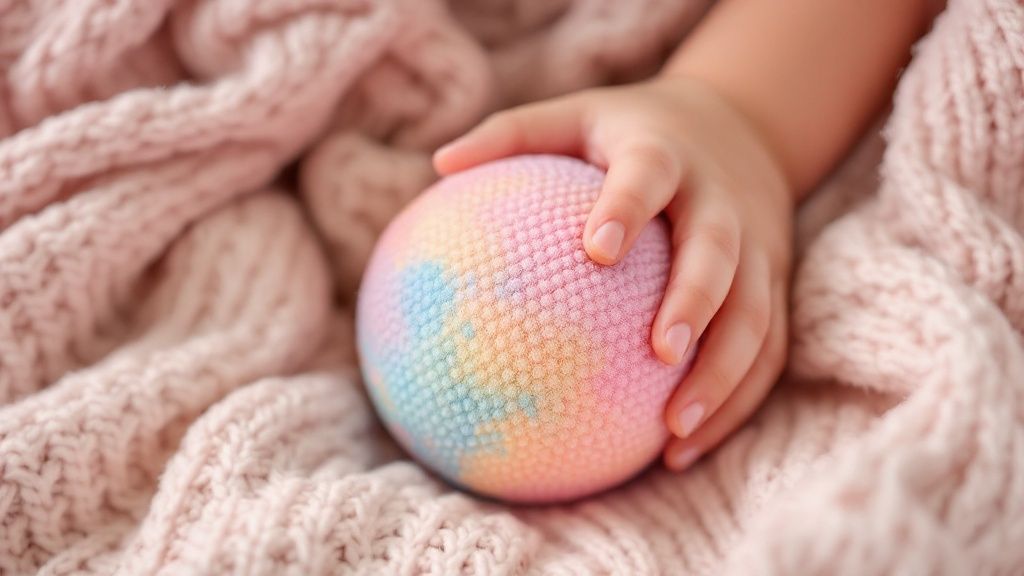Walk into any home with a toddler, and you're stepping into a vibrant, beautiful mess. It's a world of colorful blocks, well-loved stuffed animals, and puzzles with a few pieces missing. This chaos is where the magic of development happens, but for parents, the number one job is making sure that magical world is a safe one. Finding truly safe toys for toddlers is about more than just what looks fun; it’s about becoming a bit of a detective.
Your Mission, Should You Choose to Accept It: Toy Safety

Let's be real, this "mission" can feel a little overwhelming. Every toy you pick up suddenly feels like a high-stakes decision. But it doesn't have to be that stressful. Think of it less as a test and more as gaining a superpower—the power to create a secure, stimulating, and downright joyful space for your kid. The goal isn't to wrap your child in bubble wrap; it's to make sure that every belly laugh and "aha!" moment is free from preventable risks.
This guide will turn you into a confident toy investigator, someone who can spot a potential hazard from a mile away and choose toys that are as sturdy as they are delightful. We'll break it all down into simple, easy-to-remember steps.
The Four Commandments of Toddler Toy Safety
To kick things off, let's go over the core checks for any toy that dares to enter your home. Once you get these down, you'll be able to confidently navigate any toy aisle, online shop, or pile of hand-me-downs.
- What's It Made Of? We'll dive deeper than just the "non-toxic" label. We’re talking about what that plastic actually is, whether that wooden toy is properly sealed, and why it all matters.
- Size and Strength: This is the big one. For toddlers, choking is the number one concern. We’ll show you how to spot sneaky small parts, flimsy seams, and shoddy construction that could turn a toy into a hazard.
- The Age on the Box: That little age rating isn't just a friendly suggestion. It's a critical safety guideline based on how kids at that age think, play, and, let's be honest, try to destroy things.
- Decoding the Labels: Think of safety certifications as a toy's report card. Learning to read these seals and labels helps you instantly see which toys have passed the test.
Understanding why this is all so important is half the battle. The tough truth is that preventable injuries are all too common. According to the U.S. Consumer Product Safety Commission (CPSC), an estimated 206,000 children ended up in the emergency room for toy-related injuries in 2021 alone. That's a huge number, and it underscores just how much our informed choices matter. If you want to dig deeper, you can explore more data on toy safety concerns to understand the full picture.
By focusing on these four areas, you're not just buying another toy. You're buying peace of mind. You're making sure your child's playroom is a true sanctuary for imagination and growth, where the only surprises are the fun ones. Ready to start your training?
Toddler Toy Safety At a Glance
Before we dive deep, here's a quick cheat sheet. Think of this table as your go-to reference for making smart, safe choices in a snap.
| Safety Check | What to Look For | Why It Matters |
|---|---|---|
| Choking Hazards | No small parts that can fit through a toilet paper roll. Securely attached pieces (eyes, buttons, wheels). | Toddlers explore with their mouths, and anything small enough can block their airway. |
| Material Quality | Non-toxic, BPA-free, lead-free labels. Solid wood instead of particleboard. | Harmful chemicals can leach from cheap plastics and paints, posing long-term health risks. |
| Age-Appropriateness | Check the manufacturer's age recommendation (e.g., "3+"). | A toy for an older child might have small parts or complex features unsafe for a toddler. |
| Structural Integrity | Sturdy seams on stuffed toys, smooth edges on wood/plastic, no sharp points. | Poorly made toys can break easily, creating sharp edges or releasing small parts. |
| Cords & Strings | Cords or strings should be shorter than 7 inches. | Longer cords pose a serious strangulation risk. |
This table covers the absolute must-knows. Keep these points in mind, and you're already well on your way to becoming a toy safety pro.
Cracking the Code on Toy Materials
Ever feel like you need a chemistry degree just to buy a sippy cup? You stand in the aisle, scrutinizing labels for "BPA-free" and wondering what on earth "phthalate" even means. Well, it's time to bring that same detective-level energy to the toy aisle. The term "non-toxic" gets thrown around a lot, but to really get a handle on toy safety, we need to peek behind the curtain.
Think of toy materials as the ingredients list for playtime. Some are fantastic, whole-food equivalents, while others are like mystery meat—best avoided. Let's dig in and figure out what’s really in your toddler’s favorite things.
This handy guide lays out the best bets for toy materials, from the gold-standard naturals to the plastics that pass the test.

As you can see, it's all about sticking with the simple stuff—natural wood and organic fabrics are your safest foundation, with a few trusty plastics rounding out the team.
Plastic: The Good, The Bad, and The "Better Not"
Let’s be real, plastic is everywhere. It’s in our kitchens, our cars, and definitely all over the playroom. But not all plastics are playing on the same team. Some are rock-solid and safe, while others can leak nasty chemicals you don't want anywhere near your kid.
Flip over a plastic toy and you'll usually see a little triangle with a number in it. This is the recycling code, and it's your secret decoder ring for plastic safety.
- The Safe Crew (Codes #2, #4, #5): These are your go-to guys. We're talking High-Density Polyethylene (HDPE - #2), Low-Density Polyethylene (LDPE - #4), and Polypropylene (PP - #5). These plastics are tough, stable, and don't have a reputation for leaching chemicals. They're the same plastics trusted for milk jugs and yogurt cups, so they're a great choice for toys.
- The Ones to Sideline (Codes #3, #6, #7): If you see these, take a pause. Code #3 is PVC, which often contains phthalates (more on those later) to make it soft. Code #6 is polystyrene (think styrofoam), which can be brittle and break easily. And code #7 is a frustrating catch-all category that can include polycarbonate, a plastic known for containing BPA.
When it comes to plastic, here’s the bottom line: Sticking with toys made from plastics with recycling codes #2, #4, and #5 is a super simple but powerful move to keep unwanted chemicals out of your home.
When in Doubt, Go Natural
If you’re ever feeling overwhelmed by the world of plastics, just remember this: nature usually gets it right. Natural materials have been the bedrock of playtime for generations, and they come with way fewer chemical question marks.
Solid Wood: Is there anything better than a classic wooden toy? They’re built to last, they feel great in little hands, and they're even naturally antibacterial. The only thing to check is the finish. You want toys that are either unfinished or coated with non-toxic, water-based paints. Steer clear of things like particleboard or MDF, which often use formaldehyde-based glues.
Natural Fabrics: For all those soft, cuddly friends, look for materials like 100% organic cotton, wool, or hemp. These fabrics are grown without nasty pesticides, they’re super breathable, and they’re perfect for a toddler’s sensitive skin.
Watching Out for the Invisible Villains
Now for the tricky part—the hazards you can't even see. These are the chemicals that get added during manufacturing, and they can be particularly harmful to a toddler's growing body and brain.
- Lead: This stuff is a major neurotoxin. While it was banned from new toy paint in the U.S. back in 1978, it can still pop up in old hand-me-down toys or in cheap, unregulated imports. Your best defense is to buy from brands you trust to meet modern safety standards.
- Phthalates: These are the chemicals that make plastics like PVC soft and squishy. The problem is, they can mess with the endocrine system. Since toddlers explore everything with their mouths, it's a direct route for ingestion. Always look for toys clearly labeled "phthalate-free."
- BPA (Bisphenol-A): Often found in hard, clear plastics, BPA is another one of those pesky endocrine disruptors. To play it safe, just choose toys that are specifically marked "BPA-free," especially for anything that might end up in their mouth, like a teether or play food.
Becoming a pro at spotting safe materials doesn't mean you need to memorize a textbook. Just focus on the basics—solid wood, organic fabrics, and a few good plastics—and you’ll be able to confidently build a toy collection that’s 100% ready for fun.
Mastering Age-Appropriate Toy Selection
Ever find what seems like the perfect toy for your toddler, only to spot that little "Ages 3+" warning staring back at you from the box? It’s so easy to think, "Oh, but my child is so smart for their age!" Here’s the thing, though: that label has absolutely nothing to do with how clever your little one is. It’s a crucial safety warning, backed by tons of research into how kids develop and what they’re likely to do.
Think of age ratings like the guardrails on a winding mountain road. They’re put there to protect a child based on their completely normal, predictable behaviors at each stage. A toy that's perfectly harmless for a three-year-old who knows not to stick things in their mouth can be a genuine danger to a one-year-old who explores the entire world by tasting it.
The Choking Hazard Gauntlet
For toddlers, the world is one giant science experiment, and their mouth is the main laboratory. This is precisely why choking is the biggest, scariest risk when it comes to toys for this age group. A toddler's airway is shockingly small—about the same width as a drinking straw—and can get blocked in an instant.
Manufacturers use special tools to see if a toy, or any part of it, could become a choking hazard. The good news? You have a ridiculously simple and effective tool in your bathroom right now that does the same job.
The Toilet Paper Roll Test: Your At-Home Safety Gauge
It's an old-school trick for a reason: it works. If a toy or any piece that could break off can fit completely inside an empty toilet paper roll, it’s a choking hazard. Period. It's not one of the safe toys for toddlers. This simple check takes five seconds and could literally save a life.
Seriously, grab an empty roll and take a tour of your playroom. You’ll be amazed at what you find. That tiny wheel from a toy truck? A doll’s shoe? A small block that migrated from an older sibling's LEGO bin? If it fits, it’s a no-go for unsupervised toddler time.
Beyond Choking: New Dangers to Watch For
While choking gets most of the headlines, it’s not the only age-related risk lurking in the toy box. A toddler’s brain is all gas, no brakes—they lack impulse control and have zero understanding of cause and effect. This makes them vulnerable to things an older kid would instinctively avoid.
Keep these other critical dangers on your radar:
- Strings and Cords: Anything longer than seven inches is a potential strangulation risk. This applies to the cords on pull-along toys, long ribbons on stuffed animals, and even drawstrings on toy bags.
- Batteries (Especially Button Batteries): These small, shiny killers are everywhere. If swallowed, they can cause a chemical reaction that burns through the esophagus in as little as two hours. Always make sure battery compartments are screwed shut tight.
- Powerful Magnets: Those tiny, super-strong magnets from science kits or adult desk toys are a massive threat. If a toddler swallows more than one, the magnets can snap together inside the body, pinching and perforating intestines. It’s a life-threatening emergency.
The Developmental Divide
Understanding the why behind the rules makes it all click. A toddler is just getting the hang of their fine motor skills, which means their movements are clumsy and unpredictable. They don't have the strength to manage heavy toys, and they certainly don't have the foresight to see how a toy might break or be used in a dangerous way.
Think about a building set with small, intricate pieces. For a five-year-old, it’s an amazing tool for sparking creativity. For a toddler, those exact same pieces are perfectly-sized choking hazards. Or take a fantastic, screen-free tool like a dimmable LED drawing pad for kids. It's a dream for a preschooler who is refining their pincer grasp, but it might be too delicate for a one-year-old who is more likely to bang or chew on it.
That’s the developmental divide in action. Choosing age-appropriate toys isn't about holding your child back. It’s about giving them the right tools for their current skill set and predictable behaviors. When you respect the age label, you’re creating a playground where they can explore with abandon, making sure every moment of discovery is a safe one.
How to Read Toy Safety Labels and Certifications
Ever feel like you need a secret decoder ring to understand the labels on a toy box? All those jumbles of letters—ASTM, CE, CPSC—can make your eyes glaze over. But trust me, these aren't just alphabet soup; they’re your secret weapon for finding truly safe toys.
Think of these certifications as a toy’s safety passport. Before a toy gets to travel from a factory to your living room floor, it has to pass a bunch of tough inspections. Each stamp in its passport is proof that it’s been checked for specific dangers and meets a high bar for safety.
Learning to spot these stamps is a game-changer. It means you’re not just relying on a brand’s flashy marketing—you’re trusting the verdict of independent safety experts who have put that toy through its paces.
Decoding the Most Common Safety Stamps
While there are dozens of certifications out there, a few heavy hitters show up on most toys you'll find in reputable shops. Knowing what they mean tells you just how much scrutiny a toy has been under.
Here are the big ones to keep an eye out for:
- ASTM F963 (The American Standard): This is the gold standard in the United States. A toy with this label has been tested for everything from its materials (no lead or nasty chemicals) to its physical design (no sharp points or bits small enough to be a choking hazard). It's a comprehensive, top-to-bottom safety check.
- The CE Mark (The European Passport): This little mark means a toy meets the European Union’s notoriously strict requirements for safety, health, and environmental protection. It's mandatory for any toy sold in Europe, so it’s a fantastic indicator of quality and safety.
- CPSC Accepted (A Seal of Approval): In the U.S., the Consumer Product Safety Commission (CPSC) requires that all toys for kids under 12 be tested by an accredited, independent lab. A toy from a company that cares will have met this rule, confirming it follows federal safety laws.
These labels are the clearest signal that a manufacturer has actually invested time and money into making their product safe. They’ve done the hard work so you don’t have to.
The Wild West of Online Marketplaces
Now, let's talk about the internet. While trusted retailers are full of toys with valid safety passports, many huge online marketplaces are like an unregulated border crossing. Just about anyone can set up a shop and sell things, and a scary number of those toys have never seen the inside of a safety lab.
And that’s where things get terrifying. A recent 2024 study from Toy Industries of Europe (TIE) paints a shocking picture. They bought over 100 toys from third-party sellers on popular marketplaces like Amazon Marketplace, AliExpress, and Shein. The results were jaw-dropping: an incredible 80% of these toys failed basic EU safety standards. And we’re not talking about minor flaws; many posed serious choking risks or contained toxic chemicals. You can read more about these concerning findings in the full toy safety report from TIE.
This is the one thing every parent needs to hear. That bargain price on an online marketplace could come at an extremely high cost to your child’s health.
So, how do you navigate this digital minefield? You have to become your own online bouncer, being incredibly picky about where you click "buy."
To build safer shopping habits, it helps to know the signs of a trustworthy online store and how to spot the red flags. For a deeper dive, check out our guide on how to shop online safely for your family for more practical tips. By sticking to authorized retailers and official brand websites, you can dramatically reduce the risk of bringing a dangerous, uncertified toy into your home.
Spotting Hidden Dangers in the Toy Box

Okay, so you’ve become a pro at spotting safe toys in the wild aisles of the store. You’ve brought home the good stuff. But what happens after those toys have been loved, chewed on, and thrown across the room a few dozen times?
A toy’s safety isn’t a one-and-done deal at the cash register. It’s an ongoing mission. Even the most well-made toys can get worn down from all that hardcore playing, potentially turning a beloved plaything into a hidden hazard.
It’s time to put on your Toy Inspector hat. A quick, regular once-over of your toddler's toy collection is your secret weapon for keeping playtime safe and fun. It's all about catching the little problems before they become big, scary ones.
The Regular Toy Check-Up
Doing a "toy audit" sounds way more serious than it is. Really, it's just about knowing what to look for. Grab a basket, head to the playroom, and keep your eyes peeled for these common issues that can mess with even the best safe toys for toddlers.
Here’s a quick-and-dirty inspection list:
- Splintering Wood: Gently run your hands over wooden blocks, puzzles, and pull-toys. Feel any rough patches, cracks, or little splinters starting to pop up?
- Peeling Paint: Look closely for any paint that's chipping or flaking off, especially on older or hand-me-down toys. This is a classic red flag for potential lead exposure.
- Sharp Edges: That plastic dinosaur that took a tumble down the stairs might now have a crack. A single break can create an edge sharp enough to cut little hands.
- Loose Parts: Give the button eyes on teddy bears a gentle wiggle. Tug on the wheels of toy cars. If anything feels loose, it’s just a matter of time before it becomes a choking hazard.
A toy's condition can change in a flash. That wooden truck that was perfectly fine yesterday might get a nasty splinter after a particularly rowdy play session today. This is why regular checks are your best friend.
That All-Important Battery Compartment
Of all the potential dangers, one needs its own spotlight: batteries. Electronic toys are everywhere, but those little power sources are a huge risk. Button batteries, those small, shiny discs, are especially dangerous and look a lot like candy to a curious toddler.
If swallowed, a button battery can cause catastrophic, life-threatening chemical burns in as little as two hours. This is not an exaggeration. That's why the battery compartment is a non-negotiable safety feature. It must be secure. Make sure it's screwed shut on every single battery-powered toy. If the cover is broken or missing, that toy is officially retired.
Keeping the Toy Box Clean
Beyond cracks and breaks, let's face it—toys are germ magnets. A simple cleaning routine can keep your toddler healthier without needing a hazmat suit or harsh chemicals. For most toys, a little soap and water does the trick.
- Hard Plastic Toys: These guys are the easiest. A bath in warm, soapy water or a trip through the dishwasher (top rack, please!) will get them sparkling clean.
- Wooden Toys: Never, ever soak wooden toys. Water can make them warp and crack. Just wipe them down with a damp cloth—a little white vinegar mixed with water works great—and let them air dry.
- Stuffed Animals: Check the care tag first. Most plushies can handle a gentle cycle in the washing machine. You can then air-dry them or tumble them on a low-heat setting to get them fluffy again.
This isn’t about adding a huge chore to your list. It’s about building a quick habit. The table below breaks down what to look for during your regular toy sweep.
Toy Maintenance and Hazard Checklist
This checklist is your go-to guide for quick, routine toy inspections. A few minutes a week can make all the difference in keeping your child's play environment safe.
| Hazard Type | What to Check For | Action to Take |
|---|---|---|
| Choking Hazards | Loose eyes, buttons, wheels, or any small parts that have come detached. | Immediately remove the toy from the play area. Either repair it securely or discard it. |
| Sharp Points & Edges | Cracks in plastic toys, splinters on wooden toys, or exposed sharp metal parts. | Sand down any rough wooden spots. Discard any plastic toys with sharp, broken edges. |
| Battery Dangers | Loose or easily accessible battery compartments, especially for button batteries. | Ensure all battery covers are present and screwed on tightly. If a cover is missing, discard the toy. |
| Cords & Strings | Strings or cords on pull-toys that are longer than 7 inches. | Shorten the cord or remove the toy if the cord poses a strangulation risk. |
| Material Wear | Peeling paint, stuffing coming out of plush toys, or brittle, degraded plastic. | Discard toys with peeling paint. Stitch up any holes in stuffed animals or get rid of them if they are beyond repair. |
By making these quick inspections and cleaning routines a regular part of your week, you’re not just cleaning up—you’re ensuring that every toy in the box remains a source of joy, not a hidden danger.
Creating a Safe and Stimulating Play Area
You've done the hard work of picking out the perfect, safest toys. That's a huge win! But even the safest toy can get into trouble in the wrong environment. Think of it like a five-star meal—you wouldn't serve it on a dirty plate, right? The play area is the other half of the safety equation.
This space is your toddler's personal laboratory for discovery, so it needs to be ready for anything. Smart storage is your secret weapon here. Low, open shelves or bins don't just make cleanup easier; they empower your little one to choose their own adventures and, believe it or not, even help put things away. It turns tidying up from a chore into just another part of the game.
Fortifying the Play Zone
Once the clutter is managed, it's time to look at the room itself. Toddlers are born explorers and aspiring mountaineers, which means that dresser or bookshelf looks a lot like Mount Everest to them. It's absolutely crucial to anchor heavy furniture—dressers, bookcases, TV stands—directly to the wall to prevent them from tipping over.
Here are a few more quick wins to make your play space a fortress of fun:
- Cover Outlets: Those little plastic plugs or sliding covers are a must-have to keep curious fingers out of electrical sockets.
- Secure Cords: Bundle up and hide any cords from blinds, lamps, or electronics. They can be a serious strangulation hazard.
- Soften Corners: Add soft corner guards to the sharp edges of coffee tables, shelves, and other low furniture. Your shins might thank you, too!
- Gate Off-Limits Areas: A good safety gate is your best friend for blocking off stairs or rooms that haven't been fully toddler-proofed.
Taking these steps helps create a secure bubble where your child can play and learn without you having to hover constantly. It’s no surprise that parents everywhere are focusing more on this. The global market for baby and toddler toys was valued at around USD 24.5 billion in 2024 and is expected to keep climbing, which shows just how much demand there is for safe, high-quality products. You can dive deeper into the growing safe toy market on Fortune Business Insights.
Supervision is about more than just watching. When you get down on the floor and play, you're not just a safety warden; you're a co-pilot on their imaginative journeys. You’re building towers, solving puzzles, and strengthening your bond, one giggle at a time.
A safe play area isn't just a room with baby gates; it's the foundation that gives your child the confidence to explore. This same mindset applies everywhere, especially during routines like bath time. If you're building out your safety checklist, our guide on choosing the best baby bath products for a secure routine can help you splash safely.
Got Questions? We’ve Got Answers.
Alright, even with the best intentions and a checklist in hand, you’re going to have moments where you pick up a toy and just... wonder. Is this really okay? That's totally normal. Let's tackle some of the most common head-scratchers that pop up in the toy aisles and thrift stores.
We've rounded up the questions we hear all the time from parents just like you. Think of this as your cheat sheet for those tricky "what if" scenarios, so you can feel confident in every choice you make.
What's the Deal with Vintage or Second-Hand Toys?
Oh, the siren song of a charming, old-school wooden train set from the local thrift shop! It's so tempting to scoop up those nostalgic finds or accept a big box of hand-me-downs. But when it comes to toddlers, vintage toys can be a real gamble.
Here's the problem: toys made before modern safety standards were put in place, especially before 1978, are a different breed. Many were painted with lead-based paint, a major no-go for little ones who explore with their mouths. Plus, decades of love (and abuse) can make plastic brittle and wood splintery.
The absolute safest move is to buy new toys from brands you trust. If you can't resist a hand-me-down, you need to put on your detective hat. Check it over like you're inspecting a diamond—look for peeling paint, sharp edges, and any wobbly parts. And don't forget the toilet paper roll test for choking hazards!
How Do I Spot Nasty Chemicals in Plastic Toys?
This is a tricky one, because you can't just look at a plastic toy and see things like BPA or phthalates. Your superpower here is becoming a pro label-reader. Good companies are proud of their safety record and will shout it from the rooftops, plastering "BPA-free," "phthalate-free," and "PVC-free" right on their packaging.
A handy shortcut is to check the recycling code on the bottom of the plastic. Try to steer clear of toys marked with #3 (PVC), #6 (polystyrene), and #7 (other/polycarbonate), as these are the usual suspects for carrying unwanted chemicals. If there's no info and you know it's going straight into your toddler's mouth, it's best to just leave it on the shelf. When in doubt, you can't go wrong with solid, unfinished wood or 100% food-grade silicone.
Can My Toddler Play with Household Stuff?
Let's be honest, sometimes the most exciting toy in the world is a cardboard box or a set of measuring spoons. This kind of imaginative play is brilliant for their brains, but you have to apply the same safety rules. Not every household object is a-go.
Why not create a "yes box" filled with pre-approved, safe-to-play-with items?
- Plastic Food Containers: The sturdy kind, with no sharp edges.
- Wooden Spoons: A classic! Perfect for "cooking" and making a little noise.
- Cardboard Boxes: The ultimate fort, rocket ship, or canvas.
- Pots and Pans: Let them drum away while you're nearby to supervise.
Just as important is knowing what's off-limits. Never let your toddler play with keys, remote controls (those button batteries are incredibly dangerous), plastic bags, or anything that's small, sharp, or could shatter. The same rules for safe toys for toddlers apply to everything they can get their hands on.
At AMI Cart, we think playtime should be about fun and discovery, not stress and worry. Take a look at our hand-picked collection of safe, high-quality toys designed to get those little imaginations firing. Find the perfect new friend for your little one today.




